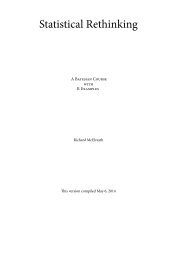the relation of habitual thought and behavior to language
the relation of habitual thought and behavior to language
the relation of habitual thought and behavior to language
Create successful ePaper yourself
Turn your PDF publications into a flip-book with our unique Google optimized e-Paper software.
RELATION OF HABITUAL THOUGHT AND BEHAVIOR TO LANGUAGE<br />
by <strong>the</strong> structure <strong>of</strong> particular <strong>language</strong>s?<br />
(2) Are <strong>the</strong>re traceable affinities between<br />
(a) cultural <strong>and</strong> <strong>behavior</strong>al norms <strong>and</strong><br />
(b) large-scale linguistic patterns? I<br />
should be <strong>the</strong> last <strong>to</strong> pretend that <strong>the</strong>re<br />
is anything so definite as 'a cor<strong>relation</strong>'<br />
between culture <strong>and</strong> <strong>language</strong>, <strong>and</strong> especially<br />
between ethnological rubrics such<br />
as 'agricultural,' 'hunting,' etc ., <strong>and</strong> linguistic<br />
ones like 'inflected,' 'syn<strong>the</strong>tic,' or<br />
'isolating." When I began <strong>the</strong> study <strong>the</strong><br />
problem was by no means so clearly formulated<br />
<strong>and</strong> I had little notion that <strong>the</strong> answers<br />
would turn out as <strong>the</strong>y did .<br />
Plurality <strong>and</strong> Numeration<br />
in SAE <strong>and</strong> Hopi<br />
In our <strong>language</strong>, that is SAE, plurality<br />
<strong>and</strong> cardinal numbers are applied in two<br />
ways : <strong>to</strong> real plurals <strong>and</strong> imaginary<br />
plurals . Or more exactly if less tersely :<br />
perceptible spatial aggregates <strong>and</strong> metaphorical<br />
aggregates . We say 'ten men'<br />
<strong>and</strong> also 'ten days .' Ten men ei<strong>the</strong>r are<br />
or could be objectively perceived as ten,<br />
ten in one group-perception-ten men<br />
on a street corner, for instance . But 'ten<br />
days' cannot be objectively experienced .<br />
We experience only one day, <strong>to</strong>-day ; <strong>the</strong><br />
o<strong>the</strong>r nine (or even all ten) are something<br />
conjured up from memory or<br />
imagination. If 'ten days' be regarded as<br />
a group it must be as an 'imaginary,' mentally<br />
constructed group . Whence comes<br />
this mental pattern? Just as in <strong>the</strong> case <strong>of</strong><br />
' We have plenty <strong>of</strong> evidence that this is not<br />
<strong>the</strong> case. Consider only <strong>the</strong> Hopi <strong>and</strong> <strong>the</strong> Ute,<br />
with <strong>language</strong>s that on <strong>the</strong> overt morphological<br />
<strong>and</strong> lexical level are as similar as, say, English<br />
<strong>and</strong> German . The idea <strong>of</strong> 'cor<strong>relation</strong>' between<br />
<strong>language</strong> <strong>and</strong> culture, in <strong>the</strong> generally accepted<br />
sense <strong>of</strong> cor<strong>relation</strong>, is certainly a mistaken one .<br />
' As we say, 'ten at <strong>the</strong> same time,' showing<br />
that in our <strong>language</strong> <strong>and</strong> <strong>thought</strong> we restate <strong>the</strong><br />
fact <strong>of</strong> group-perception in terms <strong>of</strong> a concept<br />
'time,' <strong>the</strong> large linguistic component <strong>of</strong> which<br />
will appear in <strong>the</strong> course <strong>of</strong> this paper .<br />
2 0 1<br />
<strong>the</strong> fire-causing errors, from <strong>the</strong> fact that<br />
our <strong>language</strong> confuses <strong>the</strong> two different<br />
situations, has but one pattern for both .<br />
When we speak <strong>of</strong> ten steps forward, ten<br />
strokes on a bell, or any similarly described<br />
cyclic sequence, 'times' <strong>of</strong> any sort,<br />
we are doing <strong>the</strong> same thing as with 'days .'<br />
Cyclicity brings <strong>the</strong> response <strong>of</strong> imaginary<br />
plurals. But a likeness <strong>of</strong> cyclicity <strong>to</strong> aggregates<br />
is not unmistakably given by experience<br />
prior <strong>to</strong> <strong>language</strong>, or it would be<br />
found in all <strong>language</strong>s, <strong>and</strong> it is not .<br />
Our awareness <strong>of</strong>, time <strong>and</strong> cyclicity<br />
does contain something immediate <strong>and</strong><br />
subjective-<strong>the</strong> basic sense <strong>of</strong> 'becoming<br />
later <strong>and</strong> later .' But in <strong>the</strong> <strong>habitual</strong><br />
<strong>thought</strong> <strong>of</strong> us SAE people this is covered<br />
under something quite different, which<br />
though mental should not be called subjective.<br />
I call it objectified, or imaginary,<br />
because it is patterned on <strong>the</strong> outer world .<br />
It is this that reflects our linguistic usage .<br />
Our <strong>to</strong>ngue makes no distinction between<br />
numbers counted on discrete entities <strong>and</strong><br />
numbers that are simply counting itself .<br />
Habitual <strong>thought</strong> <strong>the</strong>n assumes that in <strong>the</strong><br />
latter case <strong>the</strong> numbers are just as much<br />
counted on something as in <strong>the</strong> former .<br />
This is objectification . Concepts <strong>of</strong> time<br />
lose contact with <strong>the</strong> subjective experience<br />
<strong>of</strong> 'becoming later' <strong>and</strong> are objectified as<br />
counted quantities, especially as lengths,<br />
made up <strong>of</strong> units as a length can be visible<br />
marked <strong>of</strong>f in<strong>to</strong> inches . A 'length <strong>of</strong> time'<br />
is envisioned as a row <strong>of</strong> similar units,<br />
like a row <strong>of</strong> bottles .<br />
In Hopi <strong>the</strong>re is a different linguistic<br />
situation. Plurals <strong>and</strong> cardinals are used<br />
only for entities that form or can form<br />
an objective group . There are no imaginary<br />
plurals, but instead ordinals used<br />
with singulars . Such an expression as 'ten<br />
days' is not used. The equivalent statement<br />
is an operational one that reaches one day<br />
by a suitable count. 'They stayed ten days'<br />
becomes '<strong>the</strong>y stayed until <strong>the</strong> eleventh











